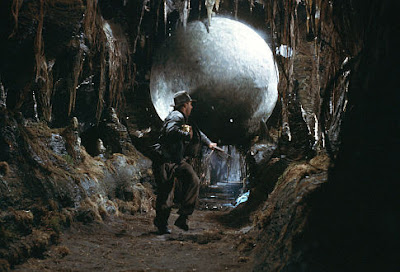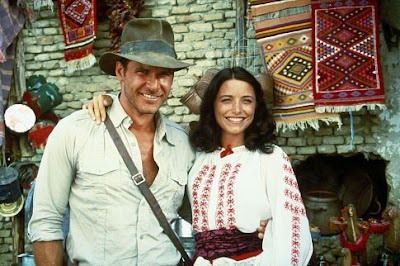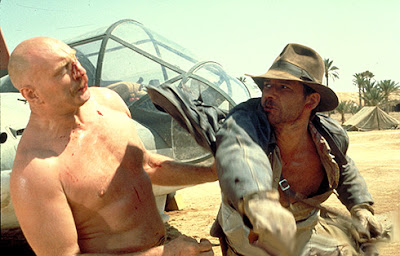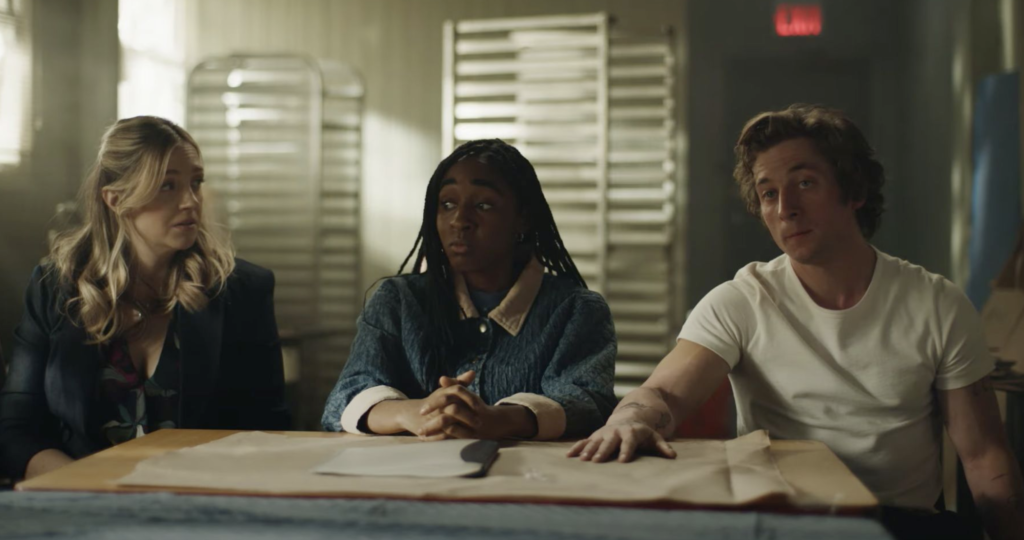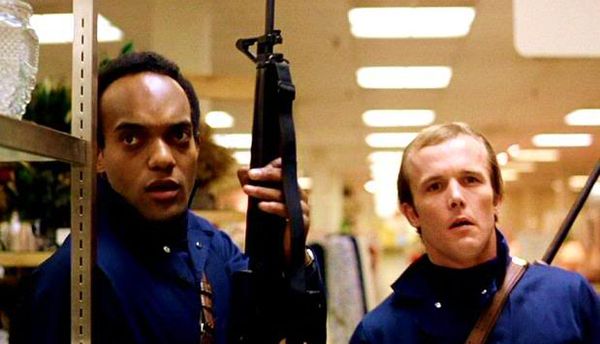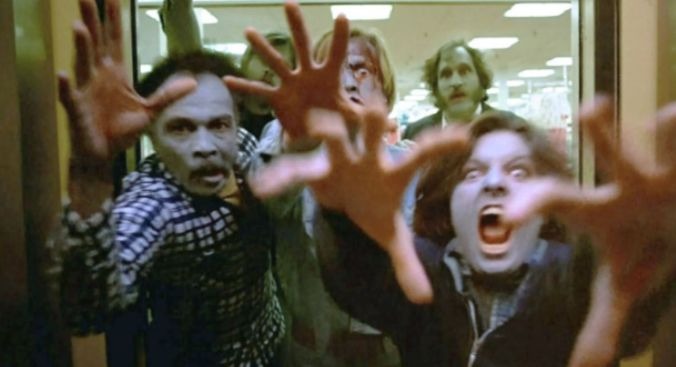Search Results for: 10 tips from
A couple of weeks back I posted my “10 Great Things About Die Hard” article and you guys responded. To quote Sally Fields: “You loved it! You really loved it!” Since I had so much fun breaking the movie down, you can expect this to be a semi-regular feature, and today I’m following it up with a film I’ve always wanted to dissect: Raiders Of The Lost Ark.
When it comes to summer action movies, there aren’t too many films that hold a candle to the perfectly crafted Raiders. Many have tried, and while some have cleaned up at the box office (Mummy, Tomb Raider
) they haven’t remained memorable past the summer they were released.
So what makes Indiana Jones such a classic? What makes this character one of the top ten movie characters of all time? Here are ten screenwriting choices that made Raiders Of The Lost Ark so amazing.
THE POWER OF THE ACTIVE PROTAGONIST
At some point in the evolution of screenwriting, a buzz word was born. The “active” protagonist. This refers to the hero who makes his own way, who drives the story forward instead of letting the story drive him. I don’t know when this buzz word became popular exactly, but I’m willing to bet it was soonafter Raiders debuted. One of the things that makes Indiana Jones such a great character is how ACTIVE he is. In the very first scene, it’s him who’s going after that gold idol. It’s him driving the pursuit of the Ark Of The Covenant. It’s him who decides to seek out Marion. It’s him who digs in the alternate location in Cairo. Indiana Jones’ CHOICES are what push this story forward. There’s very little “reactive” decision-making going on. And the man is never once passive. The “active” protagonist is the key ingredient for a great hero and a great action movie.
THE ROADMAP TO A LIKABLE HERO
Indiana Jones is almost the perfect character. Believe it or not, however, it isn’t Harrison Ford’s smile that makes Indy work. The screenplay does an excellent job of making us fall in love with him, and does so in three ways. 1) Indiana Jones is extremely active (as mentioned above). We instinctively like people who take action in life. They’re leaders. And we like to follow leaders. 2) He’s great at what he does. When we see Indiana cautiously avoid the light in the cave, casually wipe away spiders, or use his whip to swing across pits, we love him, because we’re drawn to people who are good at what they do. And 3) He’s screwed over. This is really the key one, because it creates sympathy for the main character. We watch as our hero risks life and limb to get the gold idol, only to watch as the bad guy heartlessly takes it away. If you want to create sympathy for a character, have them risk their life to get something only to have someone take it from them afterwards. We will love that character. We will want to see him succeed. I guarantee it.
ACTION SEQUENCES
When you think back to Indiana Jones, what you remember most are the great action sequences. Nearly every one of them is top notch. And there’s a reason for that. CLARITY . Each action sequence starts with a clear objective. Indiana tries to get the gold idol in the cave. Indiana must save Marion in the bar. Indiana must find the kidnapped Marion in the streets of Cairo. Indiana must destroy the plane that’s delivering the Ark. It’s so rare that we see action sequences these days with a clear objective, which is why so many of them suck. Look at Iron Man 2 for example. What the hell was that car race scene about? We have no idea, which is why despite some cool lightning whip special effects from Mickey Rourke, the scene sucked. Always create a clear objective in your action scenes.
REMIND YOUR AUDIENCE HOW DIFFICULT THE GOAL IS
High stakes are primarily created by crafting a hero who desperately wants to achieve his goal. I don’t know anyone who wants anything as much as Indiana Jones wants that Ark. But in order to build those stakes even higher, you want to remind the audience just how important and difficult it will be for your hero to achieve that goal. For example, there’s a nice little quiet scene in Raiders right before Indiana goes on his journey where his boss reminds him what finding the Ark means. “Nobody’s found the Ark in 3000 years. It’s like nothing you’ve gone after before.” It’s a small moment, but it’s a great reminder to the audience. “Whoa, this is a really big freaking deal.”
IGNORE THE RULES IF IT SUITS YOUR STORY
Part of becoming a great screenwriter is learning when rules don’t apply to the specific story you’re telling. Each story is unique and therefore forces you to make unique choices. One of the commonly held beliefs with any hero journey is that there must be a “refusal of the call.” When Luke is given the chance to help Obi-Wan, he backs down, “I can’t do that,” he says. “I still have to work on the farm.” Indiana Jones, however, never refuses the call. And Raiders is a better movie for it. Because the thing we like so much about Indiana Jones is that he’s gung-ho, that he’s not afraid of anything. So if the writers had manufactured a “refusal of the call” moment, with Indy saying, “But I have to stay here and teach. I have a dedication to the university,” it would’ve felt stale and forced. So whenever you’re trying to incorporate a rule into your story that isn’t working, consider the possibility that you may not need it.
GIVE A GREAT INTRO TO YOUR FEMALE LEAD
I can’t tell you how many male writers make this mistake (and how many female writers make this mistake in reverse). You need to put just as much thought into your female lead’s introductory scene as you do your male’s. Raiders is a perfect example of this. Indiana Jones has one of, if not the, greatest introductory scene in a movie ever. If you don’t give that same dedication and passion to Marion’s introduction, she’s going to disappear. That’s why, even though her entrance doesn’t compare to Indiana’s, it’s still pretty damn good. We have the great drinking competition scene followed by the battle with German/Nepalese thugs. The girl is badass, swallowing rum from a bullet hole leak in the middle of a life or death battle! Always always always give just as much thought to your female introduction as your male’s.
ADD IMMEDIACY AT EVERY TURN
The pace of Indiana Jones still holds up today, 25 years later. Not an easy task when you’re battling with the likes of Michael Bay and Steven Sommers, directors who have ruined audience’s attention spans with their ADD like cutting. Raiders achieves this pace not through dizzying editing tricks, but through good old fashioned story mechanics, specifically its desire to add immediacy to the story whenever the opportunity arises. Take when Indy arrives in Cairo for example. The first thing he’s told when he gets there is that the Germans are close to finding the Well of Souls! What?? This was supposed to be a simple one-man expedition! Now he’s in direct competition with a team of hundreds of men??? Because of this added immediacy, the stakes are raised and Indiana’s pursuit of his goal is more entertaining. So always look to add immediacy to your action movie where you can!
IF YOU HAVE A BORING CONVERSATION, INJECT SOME SUSPENSE INTO IT
You are always going to have two person dialogue scenes in your movie. These scenes can get very boring very quickly, especially in an action film. There’s a scene after Indy and Marion get to Cairo where they walk around the city. Technically, we don’t need this scene but it does help establish the relationship between the two, which is important for later on. Now a lesser writer may have sat these two in a room and had them divulge their pasts to each other in a boring explosion of exposition. Instead, Kasdan has them walking around, and *cutting to various bad guys getting in position to attack them.* This adds an element of suspense to the conversation, since we know that sooner or later, something bad is going to happen to our couple. MUCH more interesting than a straight forward dialogue scene between your two leads.
MOVING ON FROM DEATH IN AN ACTION MOVIE
Many times you’ll run into an issue where a major character in your movie dies. Yet you somehow must make us believe that your hero is willing to continue his journey. The perceived death of Marion creates this problem in Raiders. The formula to solve the problem? A quick 1-2 page scene of mourning, followed by the hero being placed in a dangerous situation. The mourning shows they properly care about the death, then the danger tricks the audience into forgetting about said death, allowing you to jump back into the story. So in Raiders, after Marion “dies,” Indiana sits back in his room, depressed, then gets a call from Belloq. The dangerous Belloq questions what Indie knows, followed by the entire bar prepping to shoot him. After that scene you’ll notice you’ve sort of forgotten about Marion, as crazy as it sounds. This exact same formula is used in Star Wars. Obi-Wan dies, we get the quick mourning scene on the Falcon, and then BOOM, tie fighters attack them, seguing us back into the thick of the story.
INDIANA’S ONE FAILURE – CHARACTER DEVELOPMENT
Raiders is about as perfect a movie as they come. However, it does drop the ball on one front. Indiana Jones is not a deep character. Now because this is an action movie, it doesn’t really matter. However, I’d argue that the script did hint at a character flaw in Indiana, but ultimately chickened out. Specifically, there’s a brief scene inside the tent when Indiana discovers Marion is still alive. This presents a clear choice: Take Marion and get the hell out of here, or keep her tied up so he can continue his pursuit of the Ark. What does he do? He continues his pursuit of the Ark. This proves that Indiana does have a flaw. His pursuit of material objects (his work) is more important to him than his relationships with real people (love). However, since this is the only true scene that presents this flaw as a choice, it’s the only time we really get inside Indiana’s head. Had we seen a few more instances of him battling this decision, I think Raiders would’ve hit us on an even deeper level.
Tune in next week when I dissect Indiana Jones and The Kingdom Of The Crystal Skull!
I love The Bear. It’s an extremely well-written show. So I thought, let’s bring “10 Screenwriting Tips” out of retirement so we can learn what screenwriting tricks The Bear is using to be so goooooood!
1) Obstacle Mania – Whatever your characters’ giant goal is, your job, especially in a TV show, is to place as many obstacles in front of that goal as you can. The Bear, Season 2, does this better than any show I’ve seen in recent memory. The goal is to open a new fancy restaurant. We’ve got IRS issues. Fire regulations. Finding an investor. Open in just three months. Mold. Walls falling down. Hiring competent staff. The list is never-ending. Obstacles create UNCERTAINTY IN THE NARRATIVE. Which is what you want. You want the reader to be unsure if the characters can do it.
2) Put your characters where they least want to be – Where you find the most drama in a story is when you place characters in places they do not want to be. Richie, the screw-up of the family, hates order and responsibility more than anyone in the world. This guy only thrives in chaos and disorder. In season 2, episode 7, Carmy gets Richie a job in the kitchen of the best restaurant in Chicago. Needless to say, the restaurant thrives specifically on order and responsibility. You can see Richie boiling over just standing in this place. It is the antithesis of him. Which is exactly why we can’t look away. This episode, “Forks,” is my favorite episode of Season 2 because of this lesson.
3) Intense conversations work better when at least one of the people in the conversation doesn’t want to be there – Intense dramatic conversations about life don’t usually play well. They often feel self-indulgent and fake cause kumbaya “I’m all up in my feelings” moments don’t happen all that often in real life. So a way to make them more palatable is to have at least one of the characters in the conversation not want to be there. In season 2, episode 1, an “up in his feelings” Richie is downstairs in the basement feeling bad for himself. Carmy comes down to grab something and Richie blurts out, “You ever think about purpose?” Carmy looks at him and says, “I love you but I don’t have time for this.” But then he sees Richie is really in the doldrums and decides to stay, reluctantly. Richie then makes his big, “I don’t feel any purpose” plea, and Carmy’s not really into it. He has a million things to do. But he stays and listens to the best of his ability. Carmy’s half-interest is what makes this scene work. Cause if they’re both really into this conversation, it’ll feel false.
4) Compounding outside pressure – One of the things The Bear does really well is it places pressure on its characters. But that’s par for the course. Every character should have pressure on them. What The Bear does, though, is it compounds that pressure. It adds ADDITIONAL PROBLEMS to the characters’ lives, which makes every scene feel even heavier, even more important. In “Forks,” midway through the episode, Richie calls his ex-wife, who he’s secretly hoping to get back together with, to manage a situation with their daughter. And the ex-wife tells him that she just accepted a guy’s proposal. This is what compounding pressure looks like. You never let your character off the hook. And the great thing about compounding pressure is that now, whenever Richie encounters an issue in the restaurant, we’re more afraid he’s going to crack. Cause we know that there’s additional things going on in his life.

5) The Scene Agitator – I would be surprised if creator Christopher Storer has not read Scriptshadow Secrets because this man LOVES the scene agitator. As a reminder, the scene agitator is any element you can add to a scene that agitates the characters in some way. Storer rarely lets two characters just talk to each other. He almost always has a third variable in play. For example, in season 2, episode 7, when Richie calls his cousin, Carmy, back at the restaurant, to ask him some questions, the team’s fix-it guy, Neil, is trying to fix a faulty outlet wire, which keeps electrocuting him. So Carmy is trying to talk to Richie while occasionally stopping the conversation to yell at Neil. “Neil! What are you doing! Get away from that thing.” Neil is the agitator here, and provides a more unpredictable conversation between Carmy and Richie.
6) Pronouns and Role Play – This is a preview tip from my dialogue book. A great way to spice up dialogue is to have the characters in the scene playfully use the wrong pronouns as well as use role play, pretending they’re not the people they really are. It allows for a unique conversation that always feels more creative than the on-the-nose version most writers write. In season 2, episode 8, Ebraheim, an old-timer chef at the former restaurant who bailed when Carmy decided to upgrade the restaurant, comes back a couple of weeks before the new restaurant is opening. He runs into his old buddy, Tina, who still works there.
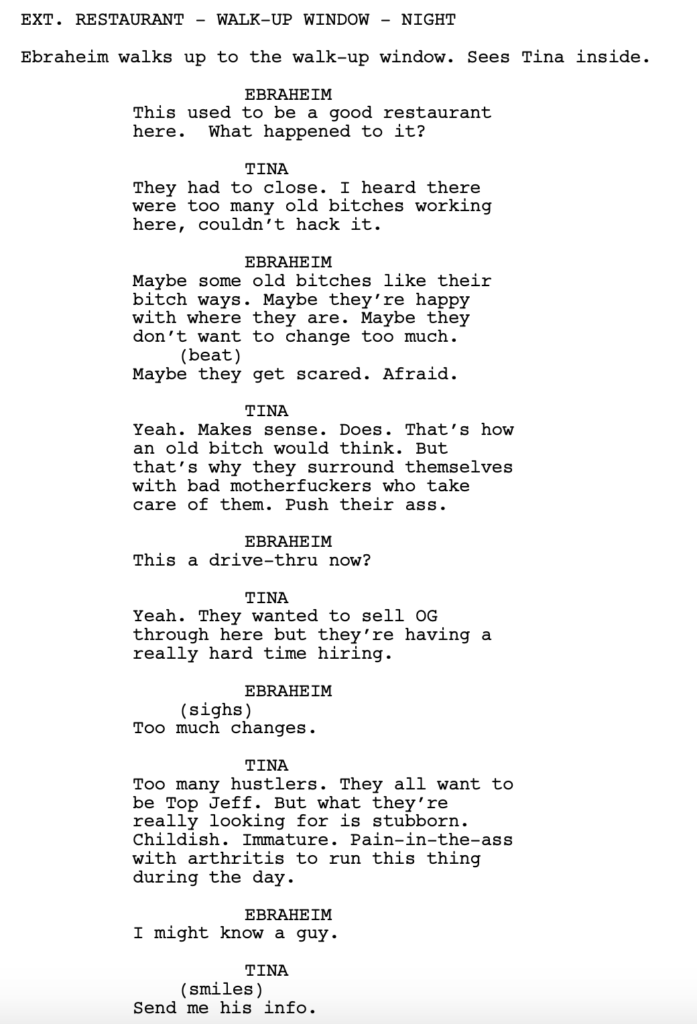
7) Nobody’s angry just because they’re angry. They’re angry because they’re scared – I read a lot of scripts where characters are angry because the writer wants an angry character. But they don’t think about WHY that character is angry. And WHY they’re angry is the whole ball of wax. Because most of the time, they’re angry because they’re scared. Cause they don’t think they can hack it. Like Richie. Richie is my favorite character in this show because of that inner conflict. He’s the loudest. He’s the harshest. He screams at people all the time. When he messes up, it’s always somebody else’s fault. And it’s all because he’s terrified. He’s terrified he’s going to be exposed for the scared little kid he actually is. So when a character is angry, give them a reason for being angry. I promise you, the character is going to come off as so much more genuine if you do.
8) Money makes the TV show go round – Money money money monaaaaay. MONNNAAAY. Money is a wonderful friend in any dramatically told story, but especially in television. The thing with TV is that it doesn’t have that ticking time bomb urgency that a movie can have since a movie is only 2 hours. With TV, the timespan is always longer and so we lose out on that urgency. You can compensate for this by adding a money issue. Your main character(s) should be under some sort of monetary deadline. With The Bear, in order to get the investment for the restaurant, Carmy has to agree that if his uncle isn’t paid back in full within 18 months, the uncle gets the building. Never having enough money is such a universal experience that we always relate to money problems in stories.
9) Make sure to balance the sour with the sweet – The Bear puts its characters through the wringer. It really whacks them up against the head with a lot of crap. If all you do, though, is hurt your characters, your reader will grow frustrated. We’re not sadists. We need good amongst your bad. And The Bear is good at this. It makes sure to intersperse the bad with a nice little occasional scene that gives you the warm and fuzzies inside. In the first episode of season 2, there’s a scene near the end of a tough episode where Sydney, the smart-as-a-whip prodigy sous-chef, runs after Tina, the old school “been here forever” cook who’s accepted her lackluster lot in life. Sydney asks Tina if she would be her assistant. And we just see Tina’s eyes light up when she realizes what Sydney is asking. It’s such a sweet moment as well as a NEEDED ONE. Because we need the sweet within the sour.
10) Scenes With a Lot of Characters In Them – The Bear has a ton of scenes with a lot of characters in them. For these scenes to work, you need to know who your CONTROLLING CHARACTER in the scene is. Your controlling character is the character who wants the most out of the scene. They have the big objective that’s driving the core of the conversation. So in Season 2, Episode 5, five minutes in, Uncle Jimmy (the investor) shows up to the restaurant to check on things. He walks into a room with, literally, seven other characters and everyone in the scene talks at some point. But the scene keeps coming back to Uncle Jimmy because he’s the controlling character. He is the one who wants the most out of this scene. He wants to know that they’re going to be ready to freaking open when they said they’re going to be ready. So that’s what drives most of the conversation, is his questions and directives regarding that topic.
100 dollars off a Screenplay Consultation (feature or pilot) if you e-mail me with the subject line, “THE BEAR!” carsonreeves1@gmail.com. What are you waiting for??
Is your screenwriting career stuck on pause? Let me help you un-pause it.
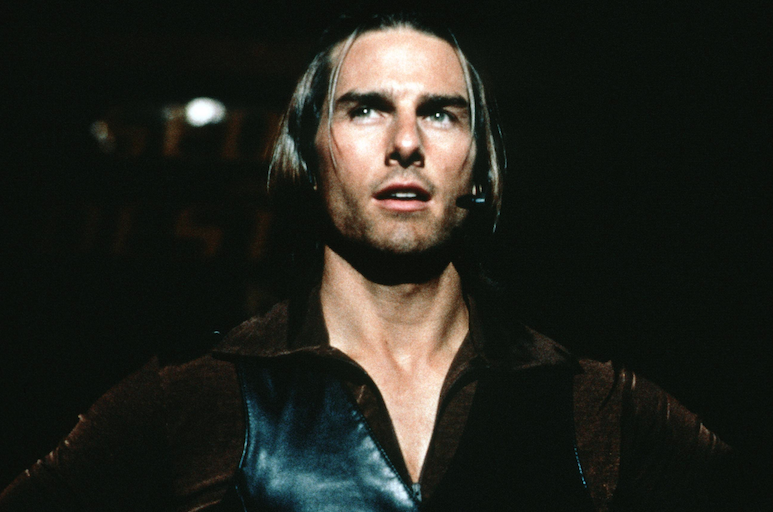
One of the hardest things about screenwriting is the solitary aspect of it. It’s the long hours you spend alone working on something when you have no idea whether it’s going to connect with people or not. This feeling of loneliness and frustration builds every time you write a script that doesn’t go anywhere. You begin to get bitter. You become convinced the system is rigged. And, tragically, you lose all motivation to write. Or at least write consistently.
I was just chatting with a writer over e-mail about this yesterday. He said he was in a really bad spot screenwriting-wise and didn’t have any motivation to write. Then he finished as one of the finalists in The Last Great Screenwriting Contest and that was the shot in the arm he needed. His latest script just got him a meeting at, arguably, the hottest action production company in town. That’s what this business is. It’s highs and it’s lows. But you have to weather the lows to get to the highs and not everybody can. Well, today, I’m going to give you ten things you can do to reignite your passion for screenwriting and get your career moving in the right direction again. All you have to do is pick one of these things, do it, and I promise you, you’re going be excited to write again.
Take Three Months Off To Study Your Biggest Weakness – Sometimes we just need to take the pressure off. Pushing out pages can be difficult when you’ve lost confidence in yourself. So why not kill two birds with one stone? First, stop writing. And second, identify what it is you’re weakest at and spend a quarter of the year studying and getting better at it. We all have that thing we suck at. For some of us, it’s dialogue. For others, it’s structure. Some of us, theme. Others, character. Create a three-month course for yourself where you study the hell out of that weakness. For example, if it’s dialogue, google 30 articles about dialogue. Watch ten dialogue-driven movies. Read twenty dialogue-driven scripts. Take meticulous notes on why the dialogue is good in these movies and compare it to your dialogue. What are they doing that you’re not? Then, when you’re all finished, write a script that specifically features your weakness and use all your newfound knowledge to write it. I guarantee you’ll find it fun because you’ll have all these new tools and concepts to play with.
Try a new genre – We’ve all heard the advice, “Get out of your comfort zone.” We know we should do it yet we never do. Why in the world would I want to be uncomfortable? Well, I don’t have to tell you that the only way to grow in an area is to place yourself in situations you’re not completely comfortable in. You’ll hear actors say this all the time. “I took this role because it scared me.” Sure, under normal circumstances, you’d like to work within the genres you’re confident in. But we’re trying to jumpstart you, get you excited about screenwriting again. With that in mind, why not try a genre you’ve never written in before? One of the unique benefits of doing this is that you’ll probably bring something fresh to the genre because you’re not beholden to it. Since it’s a one-off, you’ll have no issues breaking all the rules. Which, ironically, is going to be what makes the script so unique and fun.
Write with a partner – I know that a lot of screenwriters are particular about the way they work. They like their little routines. They don’t want anyone breathing down their neck or challenging their choices. But there’s something about writing with a partner that can really energize you. You’re more accountable now, which means you’ll write more. You learn from the other person, since they’ll have a different style than you do. And when you find someone you click with, there’s nothing like it. You’ll find that writing is fun again. And remember, you’re just working on one script together. It’s not like this person is now your wife and will be with you for the rest of your screenwriting life. You’re just trying one script with a co-writer. You might be surprised and how much it gets your juices flowing. Feel free to look for partners in the comments section below. I suggest you trade info through e-mail about how many scripts you’ve written and where you are in your careers as these pairings tend to work best when the writers are at a similar level.
Shift over into a different form of art – One of the tips I was going to give today was to quit for six months. But the more I thought about that tip, the less I liked it. I suppose it’s an option to just get away from something for awhile. But then I realized there’s a way to do this without completely abandoning screenwriting. Just slide over into an adjacent art form for six months. The one I would prefer you try is filmmaking. Specifically, make a short film on your iphone. You will definitely learn something new about screenwriting in the process. And if you like it, you become a double-threat, as you can now direct your own screenplays. But if you don’t like filmmaking, write a song. Paint. Sing. Draw. Become an amateur photographer. Do something in the arts, as I’ve found that there’s always a carryover effect where you learn something from that experience that helps you back in screenwriting. And the time off will also get you excited to write again.
Become a contest jockey for a year – A lot of writers avoid contests because they’re so subjective. And I get that. But that’s not what this advice is about. One of the issues with screenwriting is that, unless you’re a working writer, there are no deadlines. This creates a lackadaisical approach to writing where you only write “when you feel like it.” By entering 3 to 4 contests, you’ll find that you’re accountable and, therefore, forced to write. The bonus with this is that you have that possibility that your script will do well. So it gives you more motivation. If you’re wondering what contests are worth entering, people in the comments section will be happy to tell you. You can start by entering my FREE First Act Contest. Send me your title, genre, logline, anything else you want me to know, and a PDF of your first act to carsonreeves3@gmail.com by May 1, 11:59 pm Pacific Time.
Get a consultation – Am I pimping my own services? Hell yes. But I wouldn’t pimp my services unless I knew for sure it would help you. A lot of times as writers we get stuck in our heads for so long that we lose perspective. This can happen with individual scripts and it can happen with long stretches of your screenwriting career. You don’t really know what’s working anymore because how would you? You’ve only experienced rejection with little to no feedback on what you’re doing wrong. The great thing about a consultation is that you hear all those things that you knew somewhere deep in the back of your mind already, but just weren’t ready to accept. I can’t count the number of times I’ve heard that after a consult. “Deep down I knew this, Carson. But you helped me realize it’s a legitimate problem and I need to fix it.” You’ve invested years in screenwriting. Investing a little money to get a huge pick-me-up seems like a no-brainer (e-mail “CONSULTATION” to carsonreeves1@gmail.com).
Do sh#t – A few years back, I traveled to Prague for a couple of weeks, and I was more energized after that trip than at any point in my life in the last decade. Being around a new culture, experiencing new things, meeting new people, getting outside my comfort zone, it just gave me this fervor for life that had been missing. As writers, it’s important that we experience new things consistently because that’s where we draw our inspiration from. You can’t solely be inspired by movies and TV. You just can’t. Now I know not everyone can afford to travel. But that doesn’t get you off the hook. Go to bars you’d never go to. Visit a nearby town you’ve never been to. If you’re an atheist, go to a church service. Look up all the events in your city, close your eyes, spin your finger around, and whatever event it lands on, go to it. There’s nothing like the inspiration that comes from doing new things. All artists must do this.
Drop that script that’s making you miserable – You know exactly what I’m talking about. You’ve been working on this script for longer than you can remember. The script is big and complex and therefore needs a ton of rewriting, and you think if you can just redefine this one character and make the second act move a little faster and improve the arc of your villain, that it’s all going to come together. And sure, you were saying the exact same thing last year at this time, but this year you’re really going to finish it. No, man. It’s time to let that script go. It’s making you miserable. And deep down, you know it’s not fixable. Once you do this, you’re going to feel like a 1000 pound brick has been removed from your back. You’re going to feel free and you’re going to love screenwriting again.
Write a script with just two characters and all dialogue – I’m talking your Before Sunsets, 500 Days of Summer, Once, When Harry Met Sally. Why? Because these are the fastest scripts you can write. It’s screenwriting in its purest form – 2 people and dialogue dialogue dialogue. There’s something about being able to belt out a script quickly that gives you confidence. And because you can write it so fast, there’s no downside to it. If it’s bad, so what? You lost two weeks. I know that when I don’t have to worry about plot and I can just write a bunch of fun dialogue, that’s the most fun I have writing a script. And I always feel better about screenwriting afterwards.
Write a pilot – If you’re anything like me, you get a little gristly when you hear, “Write a pilot.” “A pilot?? I’m a feature writer, dude!” But here’s the cool thing about pilots. You don’t have to come up with a bunch of answers. That’s one of the things that makes feature-writing such a challenge, is that you have to come up with really compelling questions (in your first act), and then really satisfying answers (in your third act). But a pilot is just setup. You can have fun with it, especially if you’re writing something like, “Lost,” where you can set up this really wild world and leave it to your future self to figure out all the answers. Plus pilots are shorter, and therefore easier to write. So it’s a good break from what you usually do and you’ll probably find that it’s more fun than you expected.
Were you ever about to give up on screenwriting and then, magically, found your mojo again? What did you do? Share it in the comments!
I don’t think there’s ever been a time in my life where I’ve understood the movie industry less. It used to be that you’d buy a script, make the movie, release the movie, and if it did well, the movie was celebrated and everyone associated with it benefitted. If it did poorly, the movie was mocked and everyone associated with it got docked a few Hollywood credits.
These days, who knows what’s going on. There is a freaking Leonardo DiCaprio movie that can be seen over on Netflix right now *FOR FREE*. And yet, as of yesterday, more people would rather watch a film nobody’s heard of called “Stay Close,” which may or may not be a sequel to another movie nobody’s heard of called, “The Stranger.”
You’ve got an Academy Award winning screenwriter who just debuted a movie over on Amazon Prime, also for free, that has such a low profile that, up until yesterday, I thought it was called, “Keeping up With the Ricardo’s” (it’s actually titled “Being the Ricardos”). The industry has been flipped on its head.
This weekend, Hollywood debuted one wide-release film, a female ensemble spy flick called, “The 355.” Had they simply added a decimal after the “3,” they would’ve predicted its first week box office (4 million). It’s a telling moment for the industry, which just a couple of weeks ago, saw a movie land the third highest box office opening of all time in Spider-Man.
The message audiences are sending is clear: “Unless it’s got capes in it, we don’t want it.” When your clientele tells you they no longer like the product you’re giving them, you have to adjust.
One of things that Hollywood has always been good at is marketing. They know how to market anything, even serious films. They’ve learned that if they position a film late in the year and get some key critics to call it incredible, then promote a great performance or great writing or outstanding directing, and throw up a few “For Your Consideration” ads, they can influence enough people into believing it’s a ‘must-see’ experience.
To their credit, the system has helped a lot of good films that, otherwise, wouldn’t have been noticed. I’ll never forget how Danny Boyle’s Slumdog Millionaire was originally going to be a straight-to-DVD release until they decided to position it as an Oscar contender. Audiences then fell in love with it.
But this system has also promoted a lot of weak films. Nomadland is a good example. It’s not a good movie unless you’re the type of moviegoer who can have an in-depth conversation about the French New Wave movement. But the machine had to promote something and there weren’t any good “somethings” so they went with Nomadland.
This seems to be happening more and more lately.
Mank, Minari, Sound of Metal, Marriage Story, Vice, Roma, The Post, Ladybird, Call Me By Your Name, Darkest Hour, Manchester by the Sea, Phantom Thread, Fences, Moonlight, Brooklyn, and the list goes on. These are boring-to-decent movies that were overhyped enough that they attained a higher reputation than they deserved.
Now I’m sure some of you are saying, “Carson. You’re wrong! I liked [insert title from movies listed above]!” I’m not saying nobody liked these movies. I loved Parasite. I thought it was a great film. But I’m not going to argue with my non-industry friends when they say, “I don’t care how good it’s supposed to be. I have no interest in watching a Korean movie with sub-titles about class warfare.” General audiences don’t care about these films and the reason that matters in 2022 is that the industry is shifting and serious movies will be left behind if they don’t change their strategy.
The Golden Globes isn’t getting televised this year. AFI is postponed. Same with Critics Choice. Palm Springs is canceled. And The Academy Awards itself, because it’s been promoting weak films for the last half-decade, keeps losing viewers. The system doesn’t work anymore. So what do they need to do?
They need to do the indie version of what Marvel did. Marvel realized that they could expand their market if they cannibalized other genres. They’d give you a big tentpole summer movie experience along with some comedy. Along with a buddy cop film. Along with a spy movie. This is what the indie/Oscar movie market needs to do in order to survive. Unless they’re okay with 20,000 views on Amazon Prime.
The new strategy – give us adult movies that actually serve to entertain rather than try to win awards. Have you ever been to a bar and seen the guy who’s trying to be cool next to the guy who actually is cool? There’s a false bravado to the poser. There’s an underlying need to be liked. There’s a fakeness to his act that everybody sees through. That’s what movies that are trying to win Oscars come off like. They remind us of the guy at the bar who’s trying to be cool. We can all see that there’s nothing beyond the exterior.
If you want serious movies to be big again and to compete with superhero movies and to start making more than 30 million dollars, you need them to be GOOD MOVIES FIRST and awards contenders second.
The prototypical version of this is Silence of the Lambs. A serious movie that cared about entertaining us first and winning critics over second. The Wolf of Wall Street is another good example. Life of Pi, District 9, Slumdog Millionaire, The Departed, Gladiator, American Beauty, The Sixth Sense, Saving Private Ryan. The common denominator between all of these films was that they were serious adult films that prioritized entertaining people rather than preaching to them or trying to win a statue.
These days we get Promising Young Woman. And don’t get me wrong. I loved that script. But I’ve never met anyone outside of Hollywood circles who’s even heard of that movie, much less seen it. They just don’t care. And if the industry wants these people to care, get off of your own self-absorbed asses and start entertaining us. Make a movie that’s good. You have the capability to do both. You don’t have to bore us to death with Moonlight to win awards AND make money.
So like they always say: “What are you going to do about it, Carson?” Keep sitting around and complaining on your little blog? Or are you going to try and change it?
I’m going to change it.
As you know, I have my Fabulous First Act Contest coming up. Starting March 1st, I’m going to guide you through writing the first act of a new screenplay. The idea is that a lot of people are afraid of starting a screenplay because they have so much trouble finishing them. With this contest, all you have to do is write a first act. And, even better, I’m going to be coaching you through writing that first act. So you’re for sure going to finish and, if you want, enter it into my contest (details on entering will be published on April 1).
Anyway, since your chances of winning go up exponentially with a better concept, I want you to have the best concept possible ready by March 1. I’ve been seeing all types of concepts via my logline service (just $25! carsonreeves1@gmail.com) and I keep seeing similar mistakes being made over and over again. So here are five tips you can focus on for a better concept.
1) Make sure it’s a movie you would go and see – I can’t tell you how many writers send me ho-hum loglines and I’ve asked them, “Would you go see your movie?” And they always say, “Of course I would!” I would then ask them if they’ve seen a specific recent movie that’s similar to theirs. These are usually movies that have bombed because, again, they’re based off of weak concepts. Without hesitation, they say, “No.” “Well, why not?” I ask. “I don’t know. It just didn’t look interesting.” I then wait for them to understand the ramifications of what they’ve just said. But they never get it. They’re under the impression that, even though their idea is similar to a movie that nobody wanted to see, their version of the idea is, somehow, special, and people will want to see it. If you have no interest in paying to see movies similar to the one you’re writing, that’s a good indication you’re writing an idea people won’t be interested in.
2) Strange Attractor – I’ve been reading a lot of loglines lately without a “strange attractor.” The strange attractor is the element of your logline that makes it special, that makes it unlike other movies out there. Some people might even define it as “the hook.” Here’s an example of two loglines in the same genre. One without a strange attractor and one with. “After hearing rumors of zombies in town, a farming family holes up in their house for the night.” “A family must learn to live in complete silence after the world has been taken over by aliens that hunt through sound.” Zombies alone are not a strange attractor just as aliens alone are not a strange attractor. You need that extra element – hunting through sound, a family that must exist in silence – to make it a true strange attractor. The strange attractor is, I’d say, a necessity in a logline. It’s hard to get excited about a logline without one.
3) A character can be a strange attractor – Not all of us are interested in writing genre movies. Which is fine. But if you’re not writing genre movies, then you better have an amazing character who sounds interesting in a logline. They, then, become the strange attractor. “Alan Turing, an autistic gay man who would go on to become the father of the general-purpose computer and artificial intelligence, attempts to decode the mythical “Enigma” machine that the German army used to send encrypted messages during World War 2.”
4) Make sure there’s a healthy dose of conflict in your concept – Without conflict, a concept is just an idea. The conflict is what makes it a movie. So, for example, if I said to you I have an idea about a guy who realizes he’s a computer generated character in a video game, that’s still not a movie idea because you haven’t introduced the conflict yet. Now if you tell me that a computer generated character realizes he’s in a video game, starts to take over the game, forcing the game creators to try and kill him (Free Guy), now you’re forming an actual idea. The conflict is the bridge that helps the concept cross over from just an idea to an actual movie.
5) Be as specific as possible – I’d say that, roughly, one-third of the loglines I receive end with a general directionless phrase. “…until she doesn’t know what’s real and what isn’t.” “…causing him to question his life.” “…begins to see that not everything is what it appears to be.” These scripts almost always fall apart because there is no defined goal for the main character. They’re not trying to solve a murder. Or attempting to graduate college. Or trying to win over the guy of their dreams. A logline needs that clear defined path for the main character for it to sound enticing. Like above, with The Imitation Game. Alan Turning is trying to decode a machine to stop the Germans in World War 2. That’s so much better than, “Alan Turing attempts to decode the German Enigma machine, discovering along the way that, in war, there are no clear-cut answers.” Do you see how wishy-washy and generalized that ending is? That’s what we want to avoid.
I’ll have more conceptual tips for you as we get closer to the March 1. In the meantime, run with these!
Lessons from arguably the best zombie film ever made!
TODAY (THURSDAY) IS THE ‘HALLOWEEN HORROR SHOWDOWN’ DEADLINE. Get your entries in by 11:59pm tonight! The five most compelling pitches will be posted tomorrow for everyone to read and vote on. As a reminder, here’s how to enter…
What: Halloween Horror Showdown
Genre: Horror
When: Entries are due Thursday, October 21st, 11:59 PM Pacific Time
How: Include title, genre, logline, Why We Should Read, and a PDF of your script
Where: carsonreeves3@gmail.com
While I eagerly await the remainder of the horror entries, we’re going back to the zombie genre for another Halloween Horror 10 Tips! I had so much fun watching Night of the Living Dead last week, I thought we’d check out its sequel, a movie many consider to be the best zombie movie of all time. This is the movie where a group of people hole up in a shopping mall during the zombie apocalypse. Lots of good lessons to learn here!
1) Even More In Media Res – As we talked about last week, Night of the Living Dead throws us right into the action. Zombies are coming at us in the very first scene. Dawn of the Dead takes that approach and multiplies it by a thousand. We’re plopped down on a news set as zombies take over the world. Everything is falling apart in front of our eyes. People are screaming to get off the air. Newscasters are determined to stay on and keep giving the news. It’s absolute chaos. If you’ve never seen this movie, go watch it now just for the opening. It feels insanely realistic and scary. More importantly, Romero doubles down on his ‘in media res’ approach to zombies, showing us, once again, how effective it is. A tremendous opening scene (and a good follow-up scene as well).
2) Exposition Mastery – I noticed something very cool about the initial exposition being used to describe what’s happening in the world. 99% of the time in these movies, the exposition is offered through people watching the news on TV, which is a passive, and therefore, boring way to convey exposition. What Dawn of the Dead does that’s really clever is they PUT YOU IN THE ACTUAL NEWSROOM as the news is being given. Because we’re experiencing the news from the inside, as all the chaos surrounds us, the exposition feels a lot more active and compelling.
3) Create ticking time bombs WITHIN the story – When I talk about ticking time bombs, I’m often referring to the kind that frame the entire story (“The hero has 48 hours to find his missing daughter!”). But remember, you should be creating smaller “self-contained” ticking time bombs as well, as they help keep that section of the screenplay tense. For example, helicopter weatherman Stephen approaches news producer Francine and says, “Meet me out by the chopper at 9pm sharp. We’re getting out of here.” This “mini” ticking time bomb creates an intense little storyline now where we’re determined to see whether our couple gets out or not.
4) Set characters up through their reactions – I recently read a script where none of the characters stuck. I couldn’t remember them from page to page. The most common reason this happens is that the writer didn’t do enough to properly establish the character when they were introduced. A great way to establish someone is through their reactions. We see that here with Peter, the big burly SWAT team member who joins our group. He’s forced to kill a bunch of zombies who’ve been stuffed into the basement of a hotel. He must shoot each of them in the head. As he does this, one after another, he starts crying. That’s the reaction audiences latch onto. They now know this guy is a sympathetic dude who hates that he has to do this. Not only do we have a good feel for the character moving forward. But we like him as well.
5) Look for opportunities to split people up – There’s safety in numbers. Which is great in real life. But bad for horror movies. Audiences are less scared when your characters are together. Which means you should look for ways to split them up. When our heroes land their chopper for a refueling, Stephen and Francine go one way looking for supplies while Peter goes another. Now all we need is a few zombies lurking and we’ve got ourselves a couple of cool scenes to crosscut between.
6) Use your unique surroundings to create memorable moments – Not enough writers consider what’s unique about a location. Anything unique should get special attention because that’s where you’re going to give audiences things they haven’t seen before. One of the most memorable zombie kills ever occurs in Dawn of the Dead when Roger is refueling the helicopter. A zombie moves in to attack, has to climb over some boxes, and then while he’s up on the boxes, the helicopter blade slices the top of his head off. That’s way more interesting than yet another gunshot to the head. (pro-tip: A clever writer would’ve had Roger execute the kill himself, shoving the zombie up there with his own hands)
7) Old school social commentary – Probably one of the most famous examples of social commentary ever, Dawn of the Dead puts a spotlight on America’s obsession with consumption, highlighting a bunch of zombies (us) brainlessly wandering the hallways of a mall. Consume consume consume. Buy buy buy. I put this up as a reminder that if today’s highly charged social commentary topics make you squeamish, there’s other, less controversial, commentary you could be making, like Dawn of the Dead does here. If your commentary is clever enough, like “Dawn,” it will get people talking about your script for sure.
8) Start light in your second act so that it can build – Remember that your second act is going to build. So if you start out too big, you may not have anywhere to go. Romero knows we’re doing to be stuck in the mall for the whole movie so he starts off by having some fun. Have the two guys run around the mall like kids in a candy store. Everything they’ve ever wanted: absolutely free. You do this so you can start building, from “happy,” to “kinda serious,” to “serious,” to “very serious,” to “Oh shit, we’re f%$@d.”
9) Give your characters the occasional reward – Horror movies can devolve into a never-ending series of intense scenes. The monsters are getting stronger. People in the group are dying. The remaining characters are at each others’ throats. It’s important to, every once in a while, give your characters a reward that makes them feel good, and by association, makes us feel good. We get that here when our team finally gets into the gun shop. It’s a big fun moment as now they’re able to outfit themselves with a ton of weapons to take down the army of zombies. In general, there should be no singular emotion that lasts, uninterrupted, the entire screenplay. Emotion should fluctuate during a movie, from the highest of highs to the lowest of lows, and everything in between.
10) Don’t forget your relationship issues! – You have a choice when you create relationship problems between characters. You can either include a problem that’s already there at the beginning of the movie. Or you can introduce a strong relationship then add a problem to it later on. Dawn of the Dead has both. Francine is pregnant with Stephen’s baby and neither of them are sure they want to have it. That’s their issue. Peter and Roger, meanwhile, are best friends through this whole thing. There’s no problem at all. However, when Roger gets infected, Peter realizes that the time is coming where he’s going to have to kill his friend. Four characters. Two relationship issues. Both well done.


